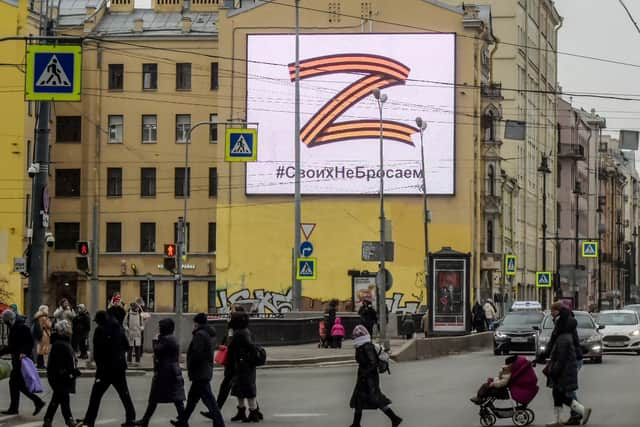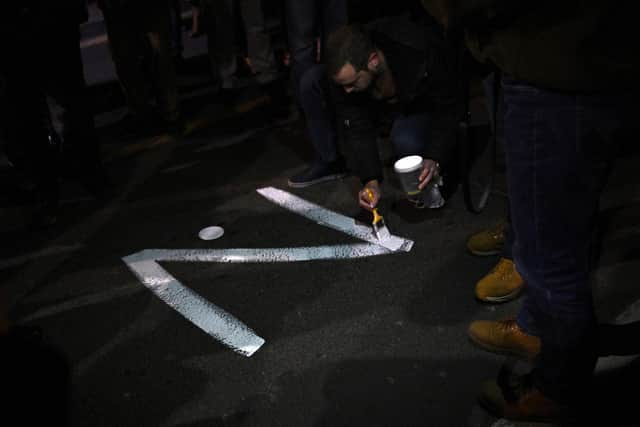Russia-Ukraine: What Russia's Z and V war symbols mean - and why Russian gymnast Ivan Kuliak wore the Z symbol
As the Ukrainian refugee crisis swells to see more than an estimated two million citizens flee the country to safety, reports of Russian shelling and missile strikes in major cities and across Ukraine are only increasing.
Despite the resistance shown by Ukrainian civilians and armed forces to the influx of Russian forces, bombardments of the country by land, air and sea continue.
Advertisement
Hide AdAdvertisement
Hide AdAnd while the Kremlin has clamped down on foreign, independent reporting of Russia’s actions in Ukraine and banned or throttled access to social media sites like Facebook and Twitter, it has sought to gain support for its so-called “military operation” in Ukraine with mysterious ‘Z’ and ‘V’ branding.
The two letters have been spotted on Russian tanks and helicopters in Ukraine, and in videos and graphics on social media.
The Russian ‘Z’ war symbol was also worn by Russian gymnast Ivan Kuliak as he received a bronze medal beside Ukrainian gold medallist Illia Kovtun at a gymnastics world championship on Saturday.
Here’s what Russia’s Z and V symbols stand for, what they mean and how they are being used in Russia’s war on Ukraine.


What does the Z symbol stand for in Russia?
The Z symbol has been spotted in Russian cities, on official government social media pages and on Russian military vehicles as part of a stepped-up guerrilla marketing campaign drumming up support for Russia’s war in Ukraine.
Z is not included in the Russian or Cyrillic alphabet, with the letter instead being taken from the Latin alphabet to reflect the pronunciation of the Russian word “за” which means “for”.
"за” has commonly featured at the beginning of patriotic Russian and Soviet Union slogans such as “за родину”, meaning “for the homeland” in Cyrillic.


It was first used on official Russian social media channels on Thursday March 3, when the Ministry of Defense of the Russian Federation posted a series of graphics emblazoned with ‘Z’ and ‘V’ symbols.
Advertisement
Hide AdAdvertisement
Hide AdThe ‘Z’ symbol was featured alongside the phrase “за победу”, meaning “for victory” and with “за мир” meaning “for peace”, but has also dominantly featured alongside the hashtag “СвоихНеБросаем” – roughly translating to “we don’t leave our own” in English.
On the Russian Ministry of Defense’s social media and Telegram channels, it has also been used to emphasise the “Z” in what Putin and Russian officials have falsely called the attempted “denazification” and “demilitarization” of Ukraine through its invasion.
On Tuesday, a video posted on the Russian Ministry of Defense’s YouTube account took the Z symbol further – showing citizens and supporters of forces engaged in what it called Russia’s “special operation” forming “ZA” on the street with lit up cars.
The video ends with the Z used to symbolise “забота о мире”, meaning ‘caring for world’ in English.
What does Russia’s V symbol mean?
Russia’s use of Z and V symbols has been used interchangeably, with ‘V’ also used in graphics to stand for ‘victory’ in Putin’s military campaign.
But it has also been closely aligned with the phrase “Сила правде” meaning “Power of Truth” and “задача будет выполнена”, which means “the task will be completed”.
It has been spotted on the side of Russian tanks rolling through Ukraine.
Why did Russian gymnast Ivan Kuliak wear Russian Z symbol?
20-year-old Russian gymnast Ivan Kuliak attached the letter 'Z' to his chest before receiving his bronze medal in the parallel bars at the Gymnastics World Cup 2022 in Doha, Qatar, on Saturday.
Advertisement
Hide AdAdvertisement
Hide AdThe event was won by Ukraine's Illia Kovtun, who was joined on the medal podium by Kuliak wearing the Z symbol.
Kuliak’s move was condemned as "shocking behaviour" by the International Gymnastics Federation (FIG) and the gymnast now faces a potential ban from future sports competitions.
But Kuliak told Russia Today on Tuesday: "If there was a second chance and I had a choice whether to go out with the letter 'Z' on my chest or not, I would do the same.
"I saw it on our military and looked at what this symbol means.
"It turned out to be 'for victory' and 'for peace'.
"I just wanted to show my position.
"As an athlete, I will always fight for victory and play for peace."
A message from the Editor:
Thank you for reading this article. We're more reliant on your support than ever as the shift in consumer habits brought about by coronavirus impacts our advertisers.
If you haven't already, please consider supporting our trusted, fact-checked journalism by taking out a digital subscription.
Comments
Want to join the conversation? Please or to comment on this article.

